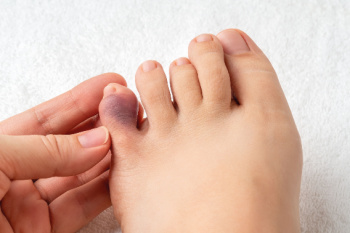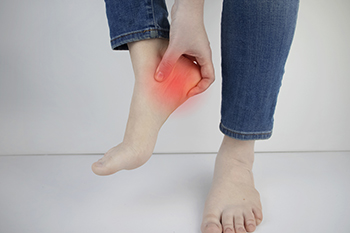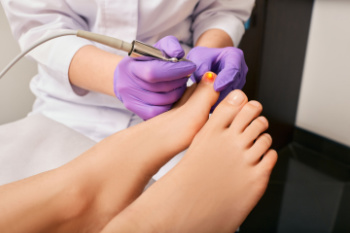
Experiencing toe pain due to a broken toe is an all-encompassing challenge that can disrupt daily life and mobility. A broken toe, often resulting from trauma or injury, can cause sharp pain, swelling, and difficulty bearing weight on the affected foot. The pain emanates from the fracture site, creating discomfort with each step and hindering the simplest of movements. Beyond the physical sensations, the inconvenience of managing daily tasks becomes palpable, as even the act of wearing shoes can exacerbate the pain. It is important to recognize the signs of a broken toe early on and it can help to seek medical attention from a podiatrist. While the road to recovery may be challenging, understanding the nature of toe pain from a broken toe and adhering to recommended treatments can significantly enhance the healing process and minimize long-term complications. If you have endured a broken toe, it is suggested that you visit this type of doctor who can guide you toward treatment and relief techniques.
Toe pain can disrupt your daily activities. If you have any concerns, contact Leonora Fihman, DPM of California. Our doctor can provide the care you need to keep you pain-free and on your feet.
What Causes Toe Pain?
Most severe toe pain is caused due to a sports injury, trauma from dropping something heavy on the toe, or bumping into something rigid. Other problems can develop over time for various reasons.
Toe pain can be caused by one or more ailments. The most common include:
When to See a Podiatrist
Diagnosis
In many cases the cause of toe pain is obvious, but in others, a podiatrist may want to use more advanced methods to determine the problem. These can range from simple visual inspections and sensation tests to X-rays and MRI scans. Prior medical history, family medical history, and any recent physical traumatic events will all be taken into consideration for a proper diagnosis.
Treatment
Treatments for toe pain and injuries vary and may include shoe inserts, padding, taping, medicines, injections, and in some cases, surgery. If you believe that you have broken a toe, please see a podiatrist as soon as possible.
If you have any questions please feel free to contact our offices located in Encino and Brentwood, Los Angeles, CA . We offer the newest diagnostic tools and technology to treat your foot and ankle needs.

Plantar fasciitis, a common cause of heel pain, can be a debilitating condition that affects daily activities. However, incorporating specific exercises into your routine can help alleviate symptoms and promote healing. Stretching exercises such as calf stretches and towel stretches target the tight muscles and fascia in the foot, reducing tension and relieving pain. Additionally, rolling a frozen water bottle or a tennis ball under the arch of the foot provides gentle massage and helps decrease inflammation. Strengthening exercises like toe curls and marble pickups improve foot stability and support, reducing strain on the plantar fascia. Additionally, practicing foot arch exercises, such as arch lifts and toe spreads, can help strengthen the arch and alleviate pressure on the plantar fascia. Consistency is key when performing these exercises, and it is important to start slowly and gradually increase intensity to avoid making symptoms worse. If you have plantar fasciitis, it is strongly suggested that you are under the care of a podiatrist who can help you manage this condition, which often includes suitable exercises and stretches.
Plantar fasciitis can be very painful and inconvenient. If you are experiencing heel pain or symptoms of plantar fasciitis, contact Leonora Fihman, DPM from California. Our doctor can provide the care you need to keep you pain-free and on your feet.
What Is Plantar Fasciitis?
Plantar fasciitis is the inflammation of the thick band of tissue that runs along the bottom of your foot, known as the plantar fascia, and causes mild to severe heel pain.
What Causes Plantar Fasciitis?
How Can It Be Treated?
While very treatable, plantar fasciitis is definitely not something that should be ignored. Especially in severe cases, speaking to your doctor right away is highly recommended to avoid complications and severe heel pain. Your podiatrist can work with you to provide the appropriate treatment options tailored to your condition.
If you have any questions please feel free to contact our offices located in Encino and Brentwood, Los Angeles, CA . We offer the newest diagnostic and treatment technologies for all your foot and ankle needs.

Pregnancy is a transformative journey marked by numerous bodily changes, including those affecting the feet. As the body undergoes hormonal shifts and weight gain, the feet bear the brunt of these transformations, often resulting in the development of various foot conditions. Swelling, or edema, is a common occurrence due to fluid retention, causing the feet to appear puffy and uncomfortable. Additionally, the increased pressure on the arches may lead to the onset or exacerbation of conditions such as plantar fasciitis or flat feet. Hormonal changes can also impact ligaments and joints, potentially causing instability and discomfort in the ankles and feet. To mitigate these issues, pregnant individuals are advised to wear supportive footwear, elevate their feet when possible, and engage in gentle exercises to improve circulation and alleviate swelling. If you have developed foot conditions during your pregnancy, it is suggested that you schedule an appointment with a podiatrist who can guide you toward finding relief.
Pregnant women with swollen feet can be treated with a variety of different methods that are readily available. For more information about other cures for swollen feet during pregnancy, consult with Leonora Fihman, DPM from California. Our doctor will attend to all of your foot and ankle needs.
What Foot Problems Can Arise During Pregnancy?
One problem that can occur is overpronation, which occurs when the arch of the foot flattens and tends to roll inward. This can cause pain and discomfort in your heels while you’re walking or even just standing up, trying to support your baby.
Another problem is edema, or swelling in the extremities. This often affects the feet during pregnancy but tends to occur in the later stages.
How Can I Keep My Feet Healthy During Pregnancy?
If you have any questions please feel free to contact our offices located in Encino and Brentwood, Los Angeles, CA . We offer the newest diagnostic and treatment technologies for all your foot and ankle needs.

Laser treatment for toenail fungus, also known as laser therapy or laser nail therapy, has gained popularity as a non-invasive approach to combat stubborn fungal infections. This innovative procedure involves directing a concentrated beam of light onto the infected nail, which penetrates the nail bed to target and destroy the fungal organisms causing the infection. Laser therapy works by generating heat that effectively eradicates the fungus while sparing the surrounding tissue. The procedure is relatively painless and typically requires multiple sessions for optimal results. While laser treatment offers several advantages, including minimal side effects and no downtime, its effectiveness varies among individuals and depends on the severity of the infection. Additionally, laser therapy may not be suitable for everyone, and results may not be immediate, requiring patience and commitment to the treatment regimen. If you have toenail fungus and are considering laser therapy, it is suggested that you consult a podiatrist who can determine if this type of treatment is appropriate for you.
Laser treatment can be an effective way to get rid of toenail fungus. If you have any questions about laser treatment, consult with Leonora Fihman, DPM from California. Our doctor will assess your condition and provide you with quality treatment for fungal nails.
What Are Toenail Fungal Infections?
Onychomycosis, or fungal infection of the nail, is a relatively common and non-serious condition. Around 10 percent of U.S. citizens are afflicted with fungal nails. Common forms of fungus that infect the nail include dermatophytes, yeasts, and molds.
Symptoms of Toenail Fungal Infections Include:
Diagnosis for Fungal Nails
Fungal infections are diagnosed by fungal culture and microscopy. This will rule out any other conditions such as nail trauma, psoriasis, lichen planus, and onychogryphosis.
What Is Laser Treatment?
Laser treatment is a non-invasive, safe, quick, and painless procedure that uses the heat from a laser to kill fungus in the nail. Each infected nail is targeted with a laser for several minutes. The treatment is usually utilized several different times over a select period. During this time, a podiatrist will keep an eye on the infection.
If you have any questions, please feel free to contact our offices located in Encino and Brentwood, Los Angeles, CA . We offer the newest diagnostic and treatment technologies for all your foot care needs.
